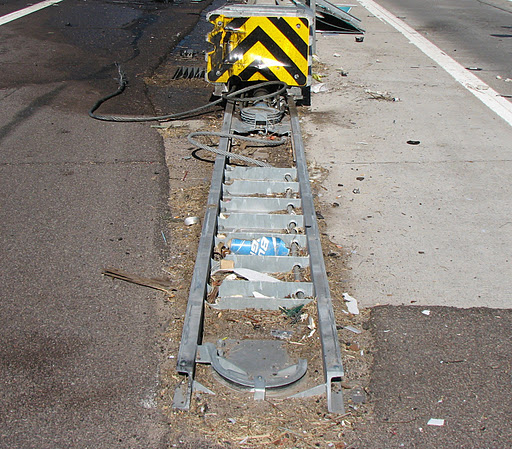Attenuators designed to take the impact of vehicle collisions
Attenuators designed to take the impact of vehicle collisions

An example of a fixed attenuator
that has been hit.
Back in July we told you all about truck-mounted attenuators and how vital they are to the safety of ADOT employees and drivers out on the road.
But, there’s another type of attenuator that acts on the same principle and does just as much to protect motorists...
Instead of being attached to a truck, fixed attenuators are placed at the end of barrier walls on the freeway. You’ll see them near off-ramps or medians and anywhere a barrier wall comes to an end.
Like truck-mounted attenuators, fixed attenuators will take the impact of a vehicle collision and absorb a lot of the energy from a crash.
This is by no means a physics blog, but a basic grasp of how energy works is needed to understand attenuators …
A vehicle’s speed and size determine how much energy it has. Normally, this energy is dissipated by your brakes, which burn off that energy slowly, allowing you to come to a safe stop.
But, if a vehicle stops by crashing into a wall, the energy is dispersed very suddenly, resulting in a car that’s crushed. Attenuators won't exactly give a soft landing, but they do work to dissipate the energy slowly like your brakes do. Various attenuators do this by different methods.
There are a few different types of fixed attenuators; however most of them will look pretty similar to drivers.
Some of the brands are built on a rail and have several compartments that hold Styrofoam blocks to absorb the impact. When a vehicle crashes into it, this type of attenuator, also known as G.R.E.A.T.s and QuadGuards, will collapse a compartment at a time and the blocks will disperse the energy. ADIEM's are made of a gypsum type composite that sit on top of an inclined base.
Another attenuator brand, known as the SCI Smart Cushion, is very similar, but instead of Styrofoam, these types of attenuators use a cable and hydraulic ram to absorb the energy.
Location and the area’s speed limit help determine which brand attenuator gets placed in certain spots.
Once an attenuator is hit by a vehicle, it needs to be fixed. ALERT Commander Tom Donithan says repairs vary depending on the type of attenuator and the severity of the crash.
Repairs to the types of attenuators designed to use Styrofoam blocks call for replacement of the blocks and other components.
Generally, the SCI Smart Cushion requires pulling the system back out and the replacement of a few bolts after it has been hit. The front shield also usually is replaced (see photo above).
Typically ADOT crews repair about five attenuators a month in the Valley region. If they’re badly damaged enough, they’ll need to be replaced and Donithan says that happens about three or four times a year in the Valley.
“They all perform the same duty, which is to protect the public from the blunt end of a barrier wall” said Donithan, adding that attenuators perform their job well and that there are very few times that his team comes across an attenuator crash where the driver doesn’t walk away. “That’s why they’re out there, because they do their job”
